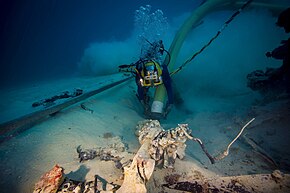
Salvage diving is the diving work associated with the recovery of all or part of ships, their cargoes, aircraft, and other vehicles and structures which have sunk or fallen into water. In the case of ships it may also refer to repair work done to make an abandoned or distressed but still floating vessel more suitable for towing or propulsion under its own power.[1][2][3] The recreational/technical activity known as wreck diving is generally not considered salvage work, though some recovery of artifacts may be done by recreational divers.
Most salvage diving is commercial work, or military work, depending on the diving contractor and the purpose for the salvage operation, Similar underwater work may be done by divers as part of forensic investigations into accidents, in which case the procedures may be more closely allied with underwater archaeology than the more basic procedures of advantageous cost/benefit expected in commercial and military operations.
Clearance diving, the removal of obstructions and hazards to navigation, is closely related to salvage diving, but has a different purpose, in that the objects to be removed are not intended to be recovered, just removed or reduced to a condition where they no longer constitute a hazard or obstruction. Many of the techniques and procedures used in clearance diving are also used in salvage work.[2]
- ^ Cite error: The named reference
Salvage manual 010was invoked but never defined (see the help page). - ^ a b Cite error: The named reference
USN Diving Manual R6was invoked but never defined (see the help page). - ^ Cite error: The named reference
Salvage manual 040was invoked but never defined (see the help page).
